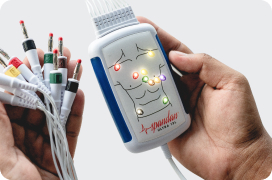
Related Article
Author:- Mr. Ritesh Sharma
The heart, a vital organ, relies on precise electrical signals to maintain its rhythm and ensure efficient blood circulation. However, disturbances in these signals can lead to abnormal heart rhythms or arrhythmias. Two common types of arrhythmias are flutter and fibrillation. While they both involve irregular heartbeats, understanding the difference between flutter and fibrillation is crucial for accurate diagnosis and effective treatment. This blog delves into the characteristics, causes, symptoms, and treatment options for both conditions to highlight the difference between flutter and fibrillation.
What is Heart Flutter?
Heart flutter, often referred to as atrial flutter, is a type of supraventricular tachycardia characterized by a rapid but regular heart rhythm. In atrial flutter, the heart’s atria (the upper chambers) beat very quickly due to abnormal electrical circuits within the atria. Despite the rapid beating, the rhythm tends to be more organized compared to fibrillation.
What is Fibrillation?
Fibrillation, on the other hand, involves rapid and chaotic electrical signals that lead to irregular heart rhythms. The most common types are atrial fibrillation (AFib) and ventricular fibrillation (VFib). Atrial fibrillation affects the atria, causing them to quiver ineffectively instead of contracting regularly. Ventricular fibrillation, which is more severe, affects the ventricles (the lower chambers) and can lead to sudden cardiac arrest if not treated immediately.
The Key Difference Between Flutter and Fibrillation
To understand the difference between flutter and fibrillation, it’s essential to compare their characteristics, causes, symptoms, and treatments.
Characteristics
- Rhythm Regularity:
- Flutter: The heart rhythm in atrial flutter is typically regular, despite being rapid. The atria may beat at a rate of around 250 to 350 beats per minute.
- Fibrillation: In fibrillation, the rhythm is highly irregular and chaotic. In atrial fibrillation, the atria may beat at rates of 350 to 600 beats per minute, but the ventricles respond at an irregular rate. Ventricular fibrillation results in completely disorganized electrical activity in the ventricles.
- Electrophysiology:
- Flutter: Atrial flutter is usually due to a reentrant circuit within the atria, creating a “sawtooth” pattern on an electrocardiogram (ECG).
- Fibrillation: Atrial fibrillation results from multiple reentrant circuits and ectopic foci within the atria, leading to a chaotic baseline on the ECG. Ventricular fibrillation shows erratic and uncoordinated electrical activity.
Causes
- Flutter: Conditions such as hypertension, coronary artery disease, heart valve disorders, and previous heart surgery can predispose individuals to atrial flutter. Sometimes, atrial flutter can occur in people without obvious heart disease.
- Fibrillation: The causes of fibrillation can overlap with those of flutter but also include other factors:
- Atrial Fibrillation: Risk factors include age, hypertension, heart disease, thyroid disorders, excessive alcohol intake, and obesity.
- Ventricular Fibrillation: It is often triggered by acute events like a heart attack, severe electrolyte imbalances, or traumatic injury to the heart.
Symptoms
While exploring the difference between flutter and fibrillation, it is vital to note their symptomatic presentations:
- Flutter: Symptoms can include palpitations, a fast but regular heartbeat, fatigue, shortness of breath, lightheadedness, and chest discomfort. Some people may be asymptomatic, especially if their ventricular rate remains controlled.
- Fibrillation: Symptoms of atrial fibrillation may overlap with those of flutter but also include an irregular and often rapid heartbeat, weakness, and reduced exercise tolerance. Ventricular fibrillation, however, leads to immediate symptoms of sudden cardiac arrest, including loss of consciousness and absence of pulse, necessitating emergency intervention.
Diagnosis
Both conditions can be diagnosed using similar methods, though the presentation on an ECG helps distinguish between them:
- Electrocardiogram (ECG):
- Flutter: Shows characteristic “sawtooth” flutter waves, especially in leads II, III, and aVF.
- Fibrillation: In atrial fibrillation, the ECG reveals an irregularly irregular rhythm without distinct P waves. Ventricular fibrillation shows erratic, disorganized electrical activity.
- Holter Monitor: Continuous ECG monitoring over 24 to 48 hours can help detect intermittent arrhythmias.
- Echocardiogram: Assesses heart structure and function to identify underlying conditions contributing to the arrhythmia.
Treatment
Treatment strategies differ significantly, emphasizing the difference between flutter and fibrillation:
- Flutter:
- Rate Control: Medications like beta-blockers and calcium channel blockers help control the heart rate.
- Rhythm Control: Antiarrhythmic drugs may be used to restore normal rhythm.
- Catheter Ablation: This procedure targets the abnormal electrical circuit causing the flutter, offering a potential cure.
- Fibrillation:
- Atrial Fibrillation:
- Rate Control: Similar to flutter, rate control can be achieved with medications.
- Rhythm Control: Antiarrhythmics or electrical cardioversion may be employed to restore normal rhythm.
- Anticoagulation: Given the high risk of stroke associated with AFib, anticoagulants are often prescribed to prevent blood clots.
- Ablation: Pulmonary vein isolation and other ablation techniques can be effective.
- Ventricular Fibrillation:
- Immediate Treatment: Defibrillation is critical to restore a normal rhythm and save the patient’s life.
- Long-term Management: May involve implantable cardioverter-defibrillators (ICDs) and addressing the underlying cause, such as revascularization in coronary artery disease.
- Atrial Fibrillation:
Understanding the difference between flutter and fibrillation is crucial for both healthcare providers and patients. While both conditions involve abnormal heart rhythms, their mechanisms, presentations, and treatments vary significantly. Atrial flutter is characterized by a rapid but regular rhythm due to a reentrant circuit, whereas fibrillation involves chaotic electrical activity leading to an irregular and often faster heartbeat. Accurate diagnosis and tailored treatment are essential for managing these conditions effectively and reducing the risk of complications. If you experience symptoms of an abnormal heart rhythm, consult a healthcare provider promptly to determine the cause and appropriate treatment.




